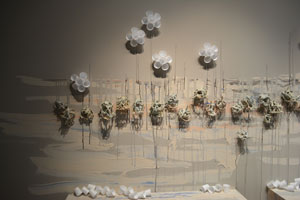



By Riley Baracski
For artist Sharbani Das Gupta, the connection of humans to each other and to the Earth is paramount. Her current exhibition, “Sharbani Das Gupta: Out Of Step,” is an ode to the Earth and it exemplifies her trademark themes of connectivity and environmental awareness.
“We put up walls and barbed wire to separate this from that,” Das Gupta said, “but the truth is, the ground flows on underneath. We are all connected through the Earth.”
“Out of Step,” which runs through Feb. 26 at in the Cathy and Jesse Marion Art Gallery at Rockefeller Arts Center, is a perfect example of her socio-environmental focus.
Das Gupta explained her process recently during a talk presented by the Department of Visual Arts and New Media through its Visiting Artist Program. She focused on her history, training and sources of inspiration.
During the presentation, she featured numerous photos of places she has traveled throughout the world, including the landscapes of her beloved New Mexico, which she currently calls home.
These landscapes feature wide-open spaces clearly set against a deep blue sky. One of the elements of these photos she made special note of was the massive cotton-like clouds, present in almost every photograph shown. She explained that she draws her inspiration mainly from these types of landscapes, where the sturdy and heat-worn Earth can crisply meet a sapphire sky that is home to the gaseous form of one of Earth’s most valuable resources: water.
In addition to the Earth, Das Gupta identified water as another source of her inspiration and many of her works shown in the presentation featured water as a main theme. Water makes up 71 percent of the Earth’s surface, so she noted it is only fitting to view the Earth as a unit that is cohesive with the oceans, rather than just solid rock. In the same way, she emphasized the importance of thinking of humankind and the Earth as one singular unit.
Her dedication to the Earth can be seen in both the themes of her artwork and through her medium of choice, clay.
Das Gupta studied the Arita technique, which is a 400-year-old Japanese porcelain tradition, at the University of New Mexico, the only university in the U.S. where this technique is taught. She graduated with a degree in Visual Communications from the National Institute of Design in India, the country of her birth, and she has held residencies around the world including in the U.S., Israel, China and Greece.
Her current Fredonia exhibition features five separate works; “Time Capsules from a Future Utopia,” “Fool’s Gold,” “Urban Blooms,” “Mind Maps,” and “In Hindsight.”
Immediately visible from the entrance to the gallery is the piece, “Time Capsules from a Future Utopia.” This piece features three identical porcelain bowls resting on individual pedestals, each with a matching glass dome placed on top. Best viewed from a circular hole through the top of the glass domes are porcelain models of large, fist sized spheres, each painted with its own unique design that is strikingly similar to a miniature globe.
The next piece, which catches the eye due to the sheer amount of space it inhabits in the middle of the gallery, is titled “Fool’s Gold.” This piece includes two sail-shaped structures, both made out of knots of clay, sailing in a sea of blue plastic that wraps itself around the sails. This piece appears to be a commentary on massive trash deposits found in the oceans – so large they appear to be islands.
 |
|
"Urban Blooms" |
Installed on a wall of the gallery is a piece called “Urban Blooms.” This piece, made from clay, clay slip, Dixie cups and wire, is a beautiful, earth-toned scene of a vine crawling up a wall, sprouting its flowers along the way. In this case, however, the blooms are Dixie cups and clay tumbleweed-like forms are interspersed within the blooms.
Nearby is the interactive piece, “Mind Maps.” This piece consists of six cubes, each with pale colored designs of maps. Each cube has a different design and texture, but it is only when one puts an eye up to one of the viewing goggles on each end of the rectangular display that the color and textures become more defined. One set of goggles is red, while the one on the opposite end of the display is blue, each color bringing out different elements in the cubes.
The last display is in the back part of the gallery, in a dark corner. “In Hindsight” is a series of pillars, each catching part of an image projected from behind the viewer. While the pillars catch images of what appear to be clouds, the large amounts of plastic tarp surrounding the bases of these pillars catch the projection in a way that almost looks like waves in an ocean, alluding to an idea that the ocean holds more than just water.
Marion Art Gallery hours are Tuesday through Thursday from noon to 4 p.m., Friday and Saturday from noon to 6 p.m., and Sunday from noon to 4 p.m. Free group tours of the exhibition may be arranged by contacting Director Barbara Räcker at 716-673-4897 or via email.
More information about Das Gupta, her work, and her achievements can be found online.